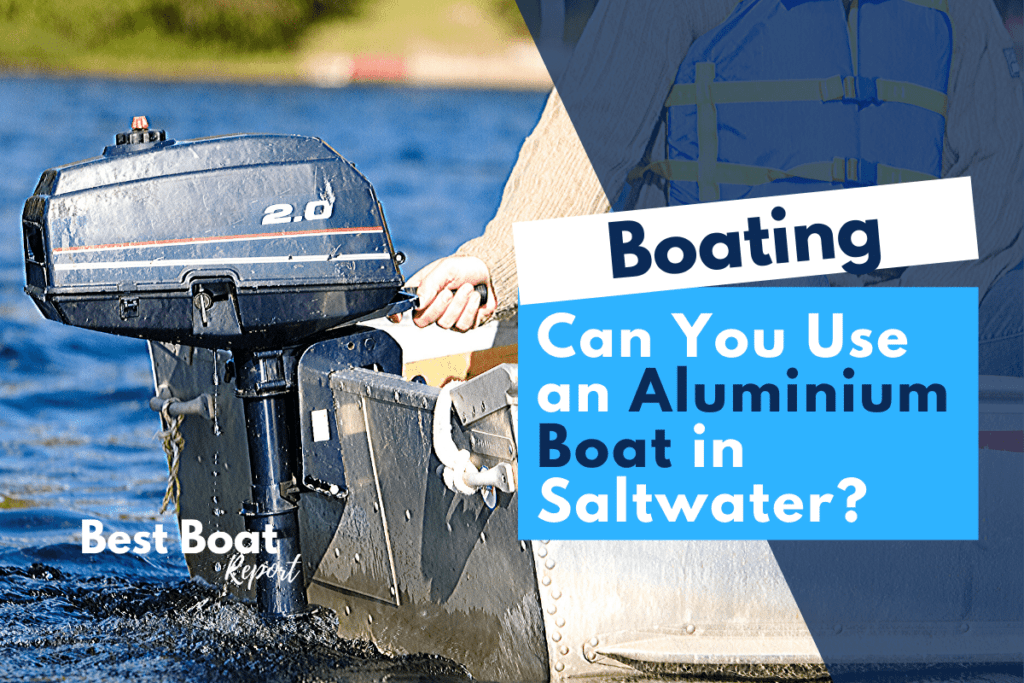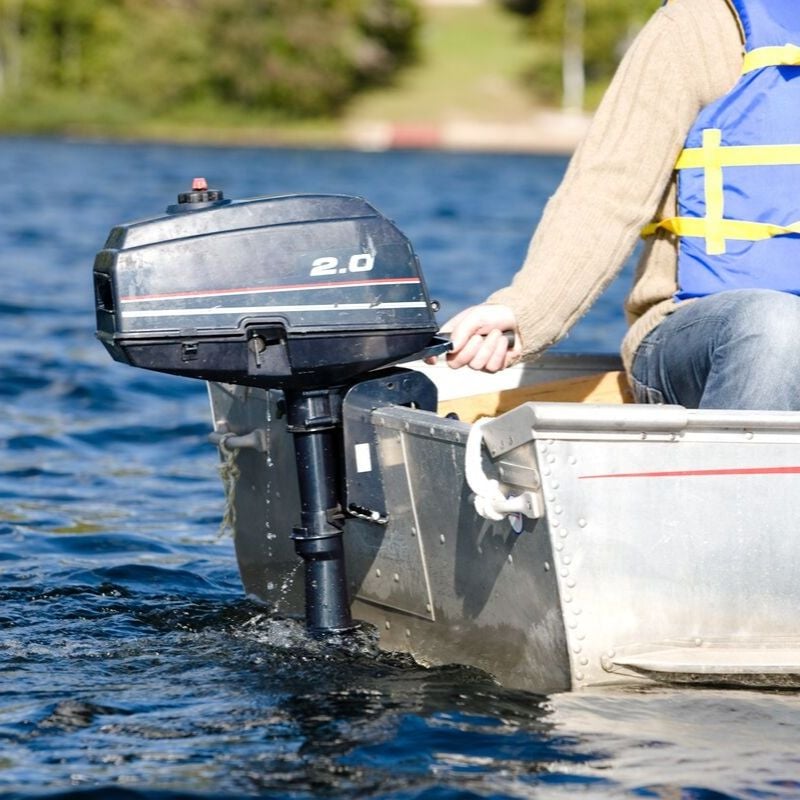Can You Use an Aluminum Boat in Saltwater? How To Protect It.
This article is about using aluminum boats in saltwater and how to protect it.
So, you’ve had several exciting experiences on those inland waters with your beloved powerboat, you’ve finally retired to warmer coastal areas, and you are wondering if you can take on the salty waters with your aluminum boat?
Or maybe your situation is different and you just want to know if it will work. Either way, keep reading and I will fill you in on the details.
Can You Use an Aluminum Boat in Saltwater?
So, can you use an aluminum boat in saltwater? Yes, you can use an aluminum boat in saltwater. This is the short answer and there is much more to know, so let’s dig into the details.

According to Ed Sherman, an education director at the American Boat and Yacht Council, Saltwater is hash stuff. He says that saltwater can corrode anything in your boat that comes in contact with it. So, it doesn’t matter what kind of propulsion system your boat uses – inboard, outboard, jet drive, I/O.
However, Mr. Sherman adds that although saltwater is not aluminum’s best friend, moving your beloved powerboat from inland to coastal waters shouldn’t make you anxious. All you need is a change in maintenance habits and anodes.
And he’s not wrong. Census statistics show that many veteran freshwater boaters eventually retire with their beloved boats to the warmer coastal climates. Fortunately, with a change in maintenance routine, they are able to keep everything in their boats one hundred.
Extra Maintenance When Using An Aluminum Boat In Saltwater

Some of the maintenance changes you are going to have to make after transitioning from freshwater to saltwater include:
• Changes to docking routine – After spending time with your boat in those coastal waters, use a trailer to get your boat out and use fresh water to wash everything down before storage.
• Removing corrosion – Stay keen on aluminum components and other metals and watch out for signs of galvanic corrosion then move to remove this corrosion.
• Protect your power plant – If you use aluminum anodes, put in place Zinc sacrificial anodes too (More on that later). Also, change anodes yearly or when they get too wasted.
• Use a solid coat of paint at the bottom of your boat – Pick anti-fouling paint such as Trilux 33 that provides a robust electrical resistance block between the aluminum and the salty water.
• Follow the manufacturer’s instructions so as not to void the warranty.
Worth mentioning is the knowledge that different propulsion systems get attacked in different parts, so watch out for that.
But most importantly, know that not all salt waters are equal. Salinity varies from region to region and has been known to increase as warmth increases or from rainy to dry periods. You have to be more vigilant when in higher-salinity waters as corrosion is much ferocious.
Here’s a further look into what saltwater does to aluminum and various components in your boat.
What Does Saltwater Do to Aluminum?
In the presence of other metals, except Zinc and Magnesium, aluminum dissolves away. This is what is known as galvanic corrosion, do you remember your science classes? Don’t worry, there is not going to be a test. Just know that when aluminum is in electrical contact with other dissimilar metals, it experiences a galvanic reaction losing some of its items to the other metal.
When it comes to aluminum vessels, saltwater facilitates electrical contact. So if your boat with an aluminum hull is sitting in saltwater next to another boat with a different Thru-Hull, say bronze, expect your boat to get corroded.
For galvanic corrosion to occur, the metals in electrical contact must have different chemical activities. That is to say, one metal must be less active in the electrochemical schoolyard than the other. In the electrochemical series, Magnesium is the most active metal followed by Zinc then our friend Aluminium, followed by Iron, Steel, Brass, etc. in that order.
Aluminum is good in both coastal and inland waters
When not in contact with different metals, aluminum on its falls apart reasonably slowly, so there’s no danger if in saltwater or freshwater. All you have to worry about is fouling. Use bottom paint to keep your boat clean. But if you want to play it safe, a protective paint coating that uses an electrical barrier to keep water from aluminum is good for boats in both types of water.
When painting your boat, however, the aluminum potion above the waterline can be left bare. This is because, with continuous exposure to oxygen, the aluminum part will develop a protective aluminum oxide layer that stops further corrosion.
Worth mentioning is that the electro-conductivity of saltwater increases with rising water temperature. So, boats in warmer coasts like Florida experience more galvanic corrosion than boats in the Chesapeake Bay.
An Example of a Galvanic Corrosion in Your Boat
The galvanic reaction between an aluminum lower unit and a stainless-steel propeller in a boat shows the corrosive effects of saltwater. The aluminum is more chemically active than stainless steel, so it is the anode, and steel is the cathode. Here’s what happens:
Electrons flow from the more chemically active aluminum lower unit via the saltwater to the stainless-steel propeller. The aluminum metal atoms that lose electrons become ions and are free to bind with the oxygen in the water to form aluminum oxide. Some of the aluminum oxide molecules drift away while the other settles onto the aluminum surface.
At the cathode, the electrons react with ions in the water, forming an alkaline solution.
The bottom line, though, much thought goes into building an aluminum boat for those coastal waters. Most builders give it all they can use the right accessories, proper welding, reinforced rivets, and assembly.
Still, once you buy the boat, it becomes your responsibility so here’s the checklist to religiously follow when using your boat in saltwater:
Watch Out for Those Anodes
Watch out for those aluminum anodes and replace them yearly or when they get more than half corroded. Also, you can use sacrificial zinc anodes in conjunction with aluminum anodes.
What are sacrificial anodes on a water craft, and how do they work? Sacrificial anodes are anodes made of more electrochemically active metals such as Zinc that are electrically connected to the aluminum components to save the aluminum parts from corrosion. They fail so the aluminum doesn’t. The Zinc anode sacrifices itself by giving its electrons to the aluminum so that aluminum loses those instead of its own electrons. That way, boatbuilders have managed to save aluminum components in boats.
But do not go crazy stuffing zinc everywhere. Use the ABYC’s procedure to determine the number and size of sacrificial anodes to use. It’s all a matter of trial and error, start with small zinc anodes, inspect how they perform, if they wear away faster, increase the size and vice versa.
You can also use milli-volts to arrive at the number of sacrificial anodes needed. Here’s how:
1. Get yourself a silver chloride electrode and a multimeter
2. Place the silver chloride electrode in the water. Make sure it’s near the metal you want to protect.
3. Establish contact between the fitting and the positive probe and then read the DC millivolts
4. Connect the Zinc of proposed size to the metal you want to protect then place it in the water and take the meter’s reading again
5. For adequate protection, adjust zinc size till meter’s new reading drops by more than 200 millivolts than reading in step 3.
Flush Engine with Freshwater After Docking

Just turn off the engine, flush out the saltwater, and run fresh water through it for 5-10 minutes to remove all salty residues. If you do this religiously, your engine will stay in good shape.
Modern outboards feature garden-hose attachments that make it easier to wash everything down when back at the docks. You can also add products such as CRC Salt Terminator to cleanse those internal components thoroughly. Rely on your manufacturer’s direction to cleaning your boat’s internals.
BONUS TIP: If your engine does not have a built-in flush system, you can use muffs like this to do the job.
Watch out Those I/O Engines
Inboard/outboard engines, some directly use salt water to cool the engine others use it indirectly in their heat exchangers. Either way, always flush the engine thoroughly after docking. Additionally, durability is an issue. Manifolds only last 3-4 years in salt water, so be prepared for replacements in addition to replacing water pumps, and risers when they get too wasted.
Paint the Bottom of the Boat
As mentioned earlier, the best paints are those that establish a robust electrical resistance barrier between the water and the bare metal aluminum. This isn’t an issue with plastic or fiberglass boats. And you don’t have to paint the part above the waterline, let aluminum oxide do its part.
Remember to replace the paintwork often. Salt is abrasive, and those dry crystals increase the sun’s intensity damaging paintwork faster.
Isolate Aluminum from Other Metallic Hardware
Use nylon plugs and washers to isolate other metals from aluminum. For example, use silicone-sealed nylon plugs on hull compartment drains and separate steel-made bolts from aluminum using nylon washers.
Brass fittings for aluminum tanks should be isolated from the tank using adaptors or stainless-steel washers too. Connect the sacrificial anodes with the aluminum anodes well.
Your zinc anode may be failing to protect the aluminum part because the two are not connected properly. Use fasteners and dedicated cast-in plates to keep the electrical connection in place. Fasteners should meet spec Mil-A-18001J as stipulated by the military.
Seal crevices and joints that would otherwise trap saltwater.
Living with your boat in saltwater will require lots of preventive protection like sealing any cracks and joints and avoiding any channels that would otherwise trap water. Avoid scratches at all costs.
Another thing to avoid is dead airspaces and carpeting that prevent moisture and condensation from draining away.
In retrospect, saltwater and aluminum, Zinc, Magnesium, iron are not best friends. But with the above tips, transitioning with your boat from inland to coastal waters shouldn’t make you sweat, stay vigilant and keep your boat components in good working order.
